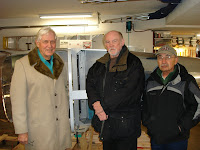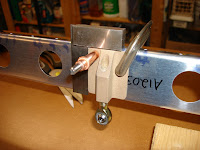 Well here I am again. To those of you who are patiently awaiting my updates, I am a dunce and a slow one at that.
Well here I am again. To those of you who are patiently awaiting my updates, I am a dunce and a slow one at that.The hardware in the picture is the Fiberglas tail cone material. It looks like this ..
 And this when completed...
And this when completed...
I finished the engine cowling. Nothing very difficult but very tedious to sand-install-fit-remove-sand-install-fit-remove...you get the picture. I am pleased now that my airplane has a face
 Even the little trapdoor for oil access came out well
Even the little trapdoor for oil access came out well It took 48 hours to finish the tail cone and engine cowling.
It took 48 hours to finish the tail cone and engine cowling.I then started on the fuel tank, preparing the metal but had to order the sealant. I switched instead to the electrical wiring. There seem to be a lot of wires in this plane. I will order the two-axis autopilot tomorrow when I place the order for the avionics kit. I included all of the optional wiring during the assembly

I tipped the fuselage on it's side and left off the turtle back and side skins. Good move on my part, suggested by both Jerry and Marty. Thanks guys. These guys really know how to blog.
I had a lot of trouble with the spar pins and the magnetic reed switches. This item should be improved to meet the elegance of design that the rest of the plane has. It is finicky and seems mickey mouse. I would have incorporated a micro switch. Anyway, after finally realizing that a reed switch was inoperative and a new one was received from Van's, I got that part completed.

I strung the rest of the wiring and installed the connectors for the autopilot. The bushings are full of wire. I don't think I can pass another strand of 22 gauge wire through some of them

Finally I wanted to install the joysticks. I passed the PTT switch wire through the joysticks.

But trouble arose when I tried to install them. The brass bushing used has an internal diameter of 0.245" on the print and the AN6 bolt has an external diameter of 0.247". This would be an interference fit of -0.002". Measuring the ID of the bushing shows it to be 0.241". This makes an interference fit of -0.006". Not going to work. A call to Van's is next.
At this point, I have 647 hours invested.
A wonderful coincidence occurred. At the suggestion of some of my fellow EAA chapter 127 members, I surfed the EAA website for technical counselors. I wanted a documentation trail of my build. Looking in the local Ohio section, I found a counselor in Oberlin Ohio. His name is Walter Edling. The first college I went to in 1965-66 was the Lorain County Community College and I received a degree in Mechanical Engineering Technology. One of my favorite professors was a Dr. Walter Edling. I figured this might be his son. When he answered the phone and I identified myself and asked him if he ever taught at LCCC he said "I remember you". So my old prof came over and was very supportive and complimentary about my build ethic and work shop. Dr. Edling is on the left. The other two are members of the EAA 255 chapter who wanted to see a RV 12.






























